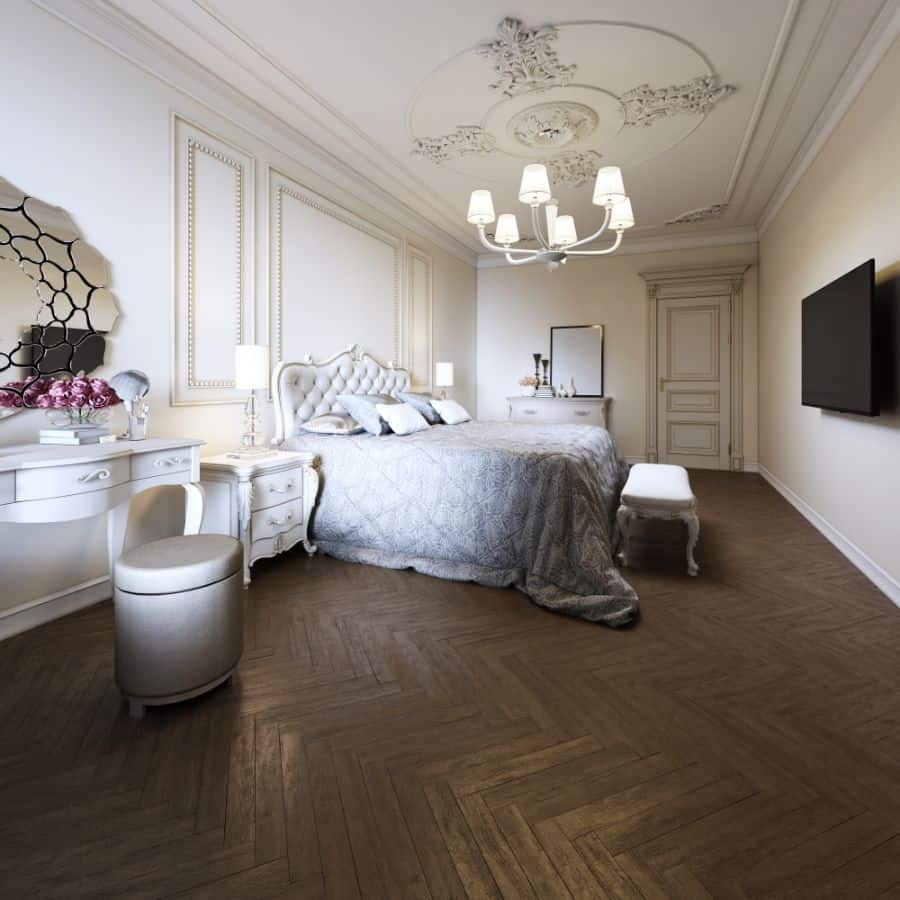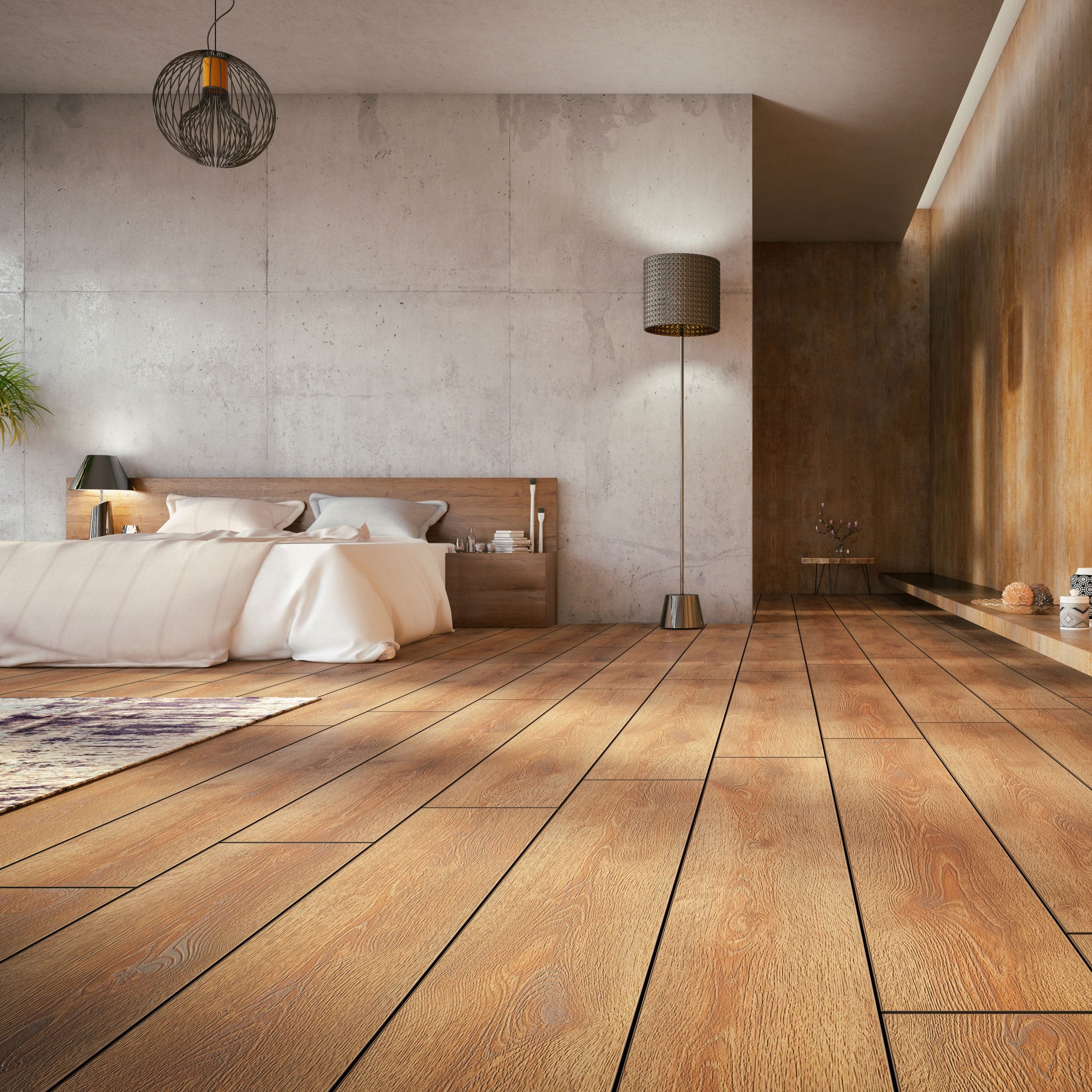Popular Bedroom Flooring Materials

Choosing the right flooring for your bedroom can significantly impact the overall look, feel, and functionality of the space. Several popular options cater to diverse preferences and budgets, each with its unique advantages and drawbacks.
Hardwood Flooring
Hardwood flooring is a timeless classic that adds warmth, elegance, and value to any bedroom.
- Durability: Hardwood floors are renowned for their durability, capable of withstanding heavy foot traffic and the wear and tear of everyday life. Hardwood species like oak, maple, and cherry are particularly resilient, offering longevity that can last for decades with proper maintenance.
- Aesthetics: Hardwood floors come in a wide range of colors, grains, and finishes, allowing for customization to match any design aesthetic. From light and airy to dark and dramatic, there’s a hardwood option to complement any bedroom decor.
- Maintenance Requirements: While hardwood floors are durable, they require regular maintenance to maintain their beauty and longevity. This includes sweeping, vacuuming, and occasional mopping with a hardwood-specific cleaner. Additionally, periodic refinishing may be necessary to address scratches or wear.
Laminate Flooring
Laminate flooring offers a cost-effective alternative to hardwood, mimicking the look of real wood without the high price tag.
- Cost: Laminate flooring is significantly more affordable than hardwood, making it an attractive option for budget-conscious homeowners. It can be installed in a fraction of the time and with less labor, further reducing costs.
- Water Resistance: Laminate flooring is designed to resist moisture, making it a suitable choice for bedrooms with potential spills or humidity. However, it’s essential to note that laminate flooring is not completely waterproof and should not be installed in areas prone to excessive moisture.
- Ease of Installation: Laminate flooring is relatively easy to install, making it a DIY-friendly option for many homeowners. The interlocking planks snap together, eliminating the need for nails or glue.
Carpet
Carpet provides a soft, comfortable underfoot experience, making it a popular choice for bedrooms.
- Sound Absorption: Carpet is an excellent sound absorber, reducing noise levels within the bedroom and improving overall privacy. This is particularly beneficial for bedrooms located in busy areas or with thin walls.
- Comfort: Carpet provides a soft and cozy surface to walk on, adding a touch of warmth and comfort to the bedroom. It’s also gentler on the feet than harder flooring options, making it a comfortable choice for those who spend extended periods of time in their bedrooms.
- Allergy Concerns: Carpet can trap dust, pollen, and other allergens, making it a concern for individuals with allergies or sensitivities. Regular vacuuming and professional cleaning are essential for maintaining a healthy environment in carpeted bedrooms.
Tile Flooring
Tile flooring is a durable and versatile option that can withstand heavy traffic and moisture.
- Durability: Tile flooring is highly durable, resistant to scratches, dents, and stains. It’s a long-lasting option that can withstand the test of time, making it a wise investment.
- Water Resistance: Tile flooring is completely waterproof, making it an ideal choice for bedrooms with potential moisture issues, such as bathrooms or laundry rooms. It’s also resistant to mold and mildew growth, promoting a healthy environment.
- Suitability for Different Climates: Tile flooring is suitable for various climates, offering both warmth in colder regions and coolness in warmer areas. It’s a versatile option that can adapt to diverse temperature conditions.
Vinyl Flooring
Vinyl flooring is a budget-friendly option that offers a wide range of styles and features.
- Affordability: Vinyl flooring is one of the most affordable flooring options available, making it an attractive choice for budget-conscious homeowners. It’s also relatively easy to install, reducing labor costs.
- Water Resistance: Vinyl flooring is highly water-resistant, making it a suitable choice for bedrooms with potential moisture issues. It’s also resistant to stains and scratches, making it a practical option for high-traffic areas.
- Design Options: Vinyl flooring comes in a wide range of styles and designs, mimicking the look of wood, stone, or even tile. This versatility allows homeowners to create a unique and personalized bedroom aesthetic.
Bedroom Flooring Trends

Bedroom flooring trends are constantly evolving, reflecting shifts in design aesthetics, material innovations, and consumer preferences. These trends are influenced by factors like sustainability, color palettes, and the desire for unique and personalized spaces.
The Rise of Wide-Plank Hardwood and Engineered Wood
Wide-plank hardwood and engineered wood flooring have gained significant popularity in bedrooms, offering a timeless elegance and a sense of spaciousness. Wide planks create a visually appealing flow, minimizing the appearance of seams and enhancing the room’s overall aesthetic. Engineered wood provides durability and stability, making it suitable for various climates and conditions.
Sustainable and Eco-Friendly Flooring Options
Consumers are increasingly prioritizing sustainability in their home choices, and bedroom flooring is no exception. Bamboo, cork, and reclaimed wood are gaining traction as eco-friendly alternatives to traditional materials. These options offer natural beauty, durability, and a reduced environmental footprint.
For example, bamboo flooring is a rapidly renewable resource that grows quickly and requires minimal processing, making it a sustainable choice for environmentally conscious homeowners.
The Influence of Color Trends on Bedroom Flooring Choices
Color trends play a significant role in shaping bedroom flooring preferences. Warm neutrals, such as beige, gray, and taupe, continue to be popular choices, providing a calming and versatile backdrop for various décor styles. Bold accent colors, like deep blues, greens, and reds, are also being incorporated into bedroom flooring to add a touch of personality and drama. Natural wood tones, ranging from light to dark, offer warmth and a sense of connection to nature.
Unique and Personalized Flooring Patterns
The desire for unique and personalized spaces is driving the demand for creative flooring patterns in bedrooms. Geometric designs, intricate mosaics, and custom-designed patterns are being used to add visual interest and character to bedroom floors.
For example, geometric tiles can create a modern and sophisticated look, while intricate mosaics can add a touch of artistry and elegance.
Technological Advancements in Bedroom Flooring, Bedroom flooring trends 2020
Technological advancements are continuously influencing bedroom flooring trends, leading to the development of innovative materials and installation methods.
- Luxury vinyl tile (LVT) has emerged as a popular alternative to traditional flooring options, offering realistic wood and stone aesthetics with enhanced durability and water resistance.
- Click-and-lock installation systems have simplified the process of installing flooring, allowing homeowners to achieve professional results with minimal effort.
Designing with Bedroom Flooring: Bedroom Flooring Trends 2020
:max_bytes(150000):strip_icc()/top-bathroom-flooring-options-1821353_hardwood-e35f154c0a76490dbc617e91080d8ef9.jpg)
Bedroom flooring is more than just a surface to walk on; it’s an integral element in shaping the room’s ambiance, functionality, and overall design. Strategic use of different flooring materials can transform a bedroom into a haven of comfort and style, enhancing its visual appeal and creating distinct zones for various activities.
Creating Distinct Zones
Employing different flooring materials in a bedroom allows for the creation of distinct zones, enhancing the functionality and visual appeal of the space. This approach offers a unique way to delineate areas for specific activities, such as reading, dressing, or relaxation.
For instance, a plush carpet in a reading nook can provide a cozy and inviting atmosphere, while durable hardwood flooring in the dressing area ensures practicality and elegance. This approach not only defines the space but also adds a layer of visual interest to the bedroom.
Organizing Bedroom Space Using Flooring Patterns and Textures
Floor patterns and textures play a crucial role in organizing a bedroom space, enhancing its visual appeal and functionality. Carefully chosen patterns and textures can guide the eye, create a sense of flow, and define different areas within the room.
- Stripes: Horizontal stripes can make a room appear wider, while vertical stripes can create an illusion of height. This can be particularly beneficial in smaller bedrooms.
- Geometric Patterns: Geometric patterns, such as chevrons or herringbone, add a touch of sophistication and can be used to create visual interest in a large bedroom.
- Textures: Textured flooring, such as carpets with a high pile or wood with a distressed finish, can add warmth and depth to a room.
Complementing Bedroom Style and Color Scheme
Choosing flooring that complements the overall style and color scheme of the bedroom is essential for achieving a cohesive and harmonious design.
- Modern Style: Sleek, minimalist flooring options like polished concrete or large-format tiles are ideal for modern bedrooms. These materials create a clean and contemporary aesthetic.
- Traditional Style: Hardwood flooring in warm tones or patterned carpets with traditional motifs complement traditional bedroom styles. These choices create a classic and timeless feel.
- Bohemian Style: Natural materials like jute or sisal rugs, combined with wood flooring, create a relaxed and eclectic atmosphere that complements a bohemian style bedroom.
Creating Different Atmospheres with Flooring
Flooring choices can significantly impact the overall feel of a bedroom, creating a sense of warmth, spaciousness, or intimacy.
- Warmth: Soft carpets in rich colors and textures create a cozy and inviting atmosphere, promoting relaxation and comfort. Natural wood flooring also adds warmth and a sense of grounding.
- Spaciousness: Light-colored flooring, especially in large format tiles or planks, can visually expand a small bedroom. Glossy finishes also reflect light, creating a more spacious feel.
- Intimacy: Darker flooring tones, particularly in wood or carpets with a deep pile, can create a more intimate and cozy atmosphere, ideal for smaller bedrooms or those seeking a sense of seclusion.
Selecting the Right Flooring for Your Bedroom
Several factors influence the selection of appropriate flooring for a bedroom, including the room’s size, natural light, and intended use.
- Room Size: Smaller bedrooms benefit from light-colored flooring and simple patterns to create a sense of spaciousness. Larger bedrooms can accommodate bolder patterns and darker colors.
- Natural Light: Rooms with ample natural light can handle darker flooring tones, while rooms with limited light require lighter options to enhance brightness.
- Intended Use: High-traffic areas within the bedroom, such as the dressing area, require durable flooring options like hardwood or tile. Areas dedicated to relaxation, such as reading nooks, can benefit from softer carpets.
Bedroom flooring trends 2020 – The year 2020 saw a surge in popularity for natural materials in bedroom flooring, with bamboo and cork gaining traction for their eco-friendly and warm appeal. When it comes to small spaces, maximizing every inch is key, and a small crib for bedroom can be a stylish and functional solution.
This trend towards natural materials in flooring is not just about aesthetics; it also aligns with the growing focus on sustainable living and creating a serene, inviting bedroom environment.
While wood-look tile continues to be popular for bedroom flooring in 2020, many are opting for the comfort and warmth of carpet. If you’re a fitness enthusiast with limited space, consider incorporating a treadmill in small bedroom. This allows you to create a dedicated workout area while keeping your bedroom’s aesthetic consistent with your flooring choice.
